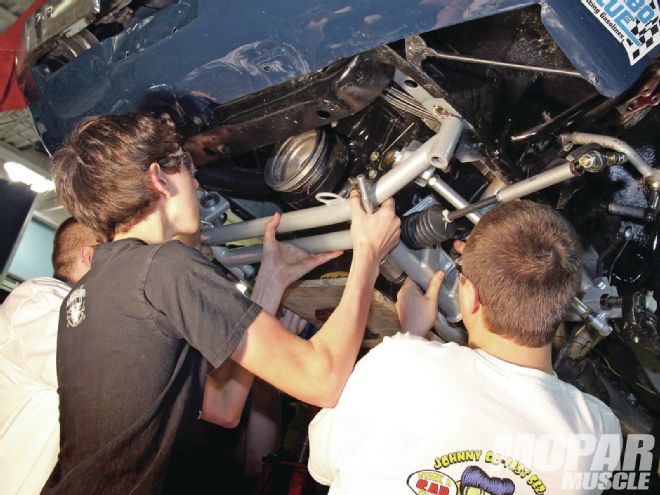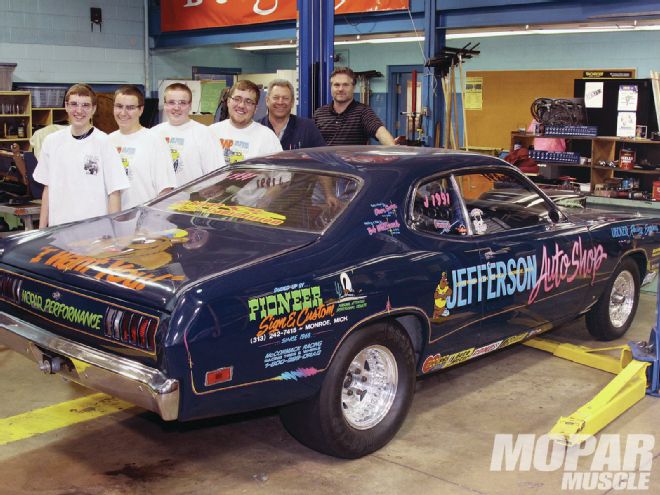
If there is one modification to a Mopar that draws a lot of attention with readers, it's the addition of a tubular K-frame. Love it or hate it, the swapping of a tubular K-frame in a muscle Mopar is a swap that will be around for quite some time. By swapping the K-frame, the car owner can now-very easily-install rack-and-pinion steering, eliminate the torsion bars, thereby gaining header clearance, and even make a later model engine a bolt in. Yep, a tubular K-frame upgrade can yield a lot of benefits. But, how easy are they to install?
When we found out that Jefferson High School in Monroe, Michigan, has a '71 Demon that serves as both educational tool and competitive drag racer, and that they wanted to install a tubular k-frame, we decided to follow along on the install and see how easy it really is. The K-frame they chose to install is from CAP Auto Products. The CAP tubular front suspensions are light, strong, and take up a ton less space than their factory counterparts. This one sports both coilover shocks and a rack-and-pinion steering system, but they also have versions available that still incorporate OEM steering and torsion bars.
The guys at CAP designed their kit to bolt directly in place of your heavy and bulky factory hardware, shedding nose weight, and improving suspension response. A tubular K-frame also provides tons of additional oil pan and header clearance. CAP's K-frame can be ordered to accommodate small or big-block engines, including the new 5.7 or 6.1 Hemi. CAP's kits are said to permit the highest amount of suspension travel on the market, and are unique in their retention of both factory motor mounts and steering geometry. The seamless, cold-drawn tubular hardware is jig machined and welded, then E-coated, inside and out, prior to powdercoating (in a variety of colors), and kits are shipped fully assembled.
Perhaps the best part is that CAP's strong, light tubular components are easy to install either individually by interchanging with OEM stamped components, or as complete spindle-to-spindle assemblies. How easy? Let's find out.
School Wasn't Like This When I Was a Kid
The "kids" shown feverishly laboring on the Demon are enrolled in Jefferson High School's Drag Team, a strictly voluntary, after-class, one-evening-a-week program in which students go beyond normal auto shop curriculum to learn the finer points of race car preparation, maintenance, and competition. Running since 1982, the program requires good scholastic grades before applicants can enroll. Under the also-voluntary supervision of auto shop instructor, Rob Eppler, and Bob Williams (Rob's counterpart from the school's fabrication/auto body shop), the Drag Team's high-performance curriculum might include such tasks as rebuilding the Dodge's small-block, transmission or rear end, rewiring, roll-cage fabrication, or whatever else is necessary to keep the quarter-miler healthy and competitive.
 The Jefferson High School Drag Team. The one on wheels is a ’71 Demon, now running an aluminum-headed 360, race-prepped 904 TorqueFlite with a 3,500-stall converter, and 4.88 gears and a spool in the rear. It’s capable of 10.90s at around 120 mph. From left to right are: Zack Perry, Mike Brancheau, Jason Lingar, Mike McLaughlin, and instructors, Rob Eppler and Bob Williams.
The Jefferson High School Drag Team. The one on wheels is a ’71 Demon, now running an aluminum-headed 360, race-prepped 904 TorqueFlite with a 3,500-stall converter, and 4.88 gears and a spool in the rear. It’s capable of 10.90s at around 120 mph. From left to right are: Zack Perry, Mike Brancheau, Jason Lingar, Mike McLaughlin, and instructors, Rob Eppler and Bob Williams.
Perhaps better yet, when the Michigan snow finally melts each spring, they pack up and accompany the Demon out to nearby Milan Dragway and campaign the Demon in the "High School Nationals" series, where it has been extremely competitive, year after year. The students not only wrench on the Dodge; each season, one amongst them is designated to don the helmet and do the bulk of the driving (everyone gets a chance to make some passes during test and tune sessions.)
Sounds like a graduate course for gearheads.